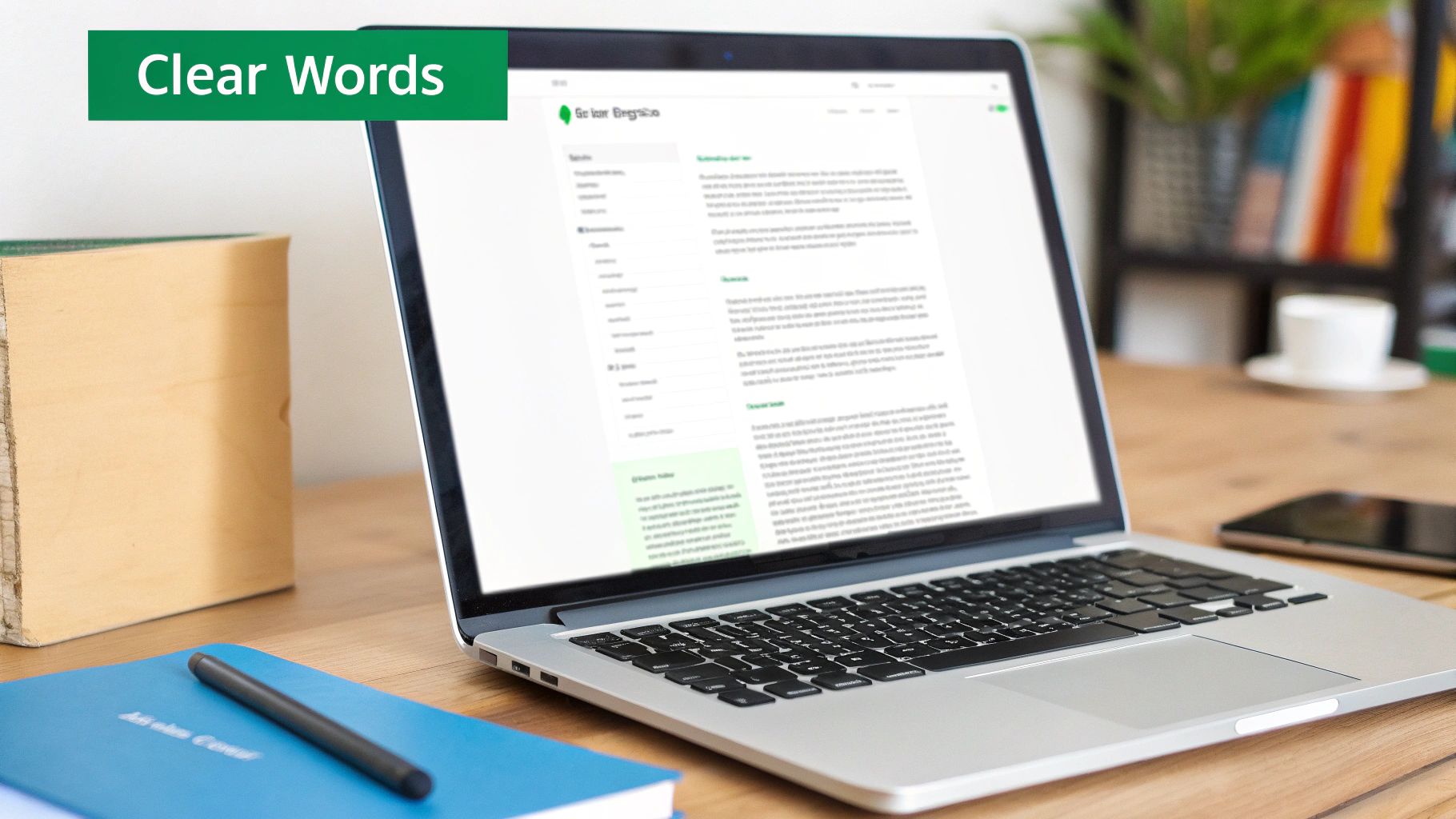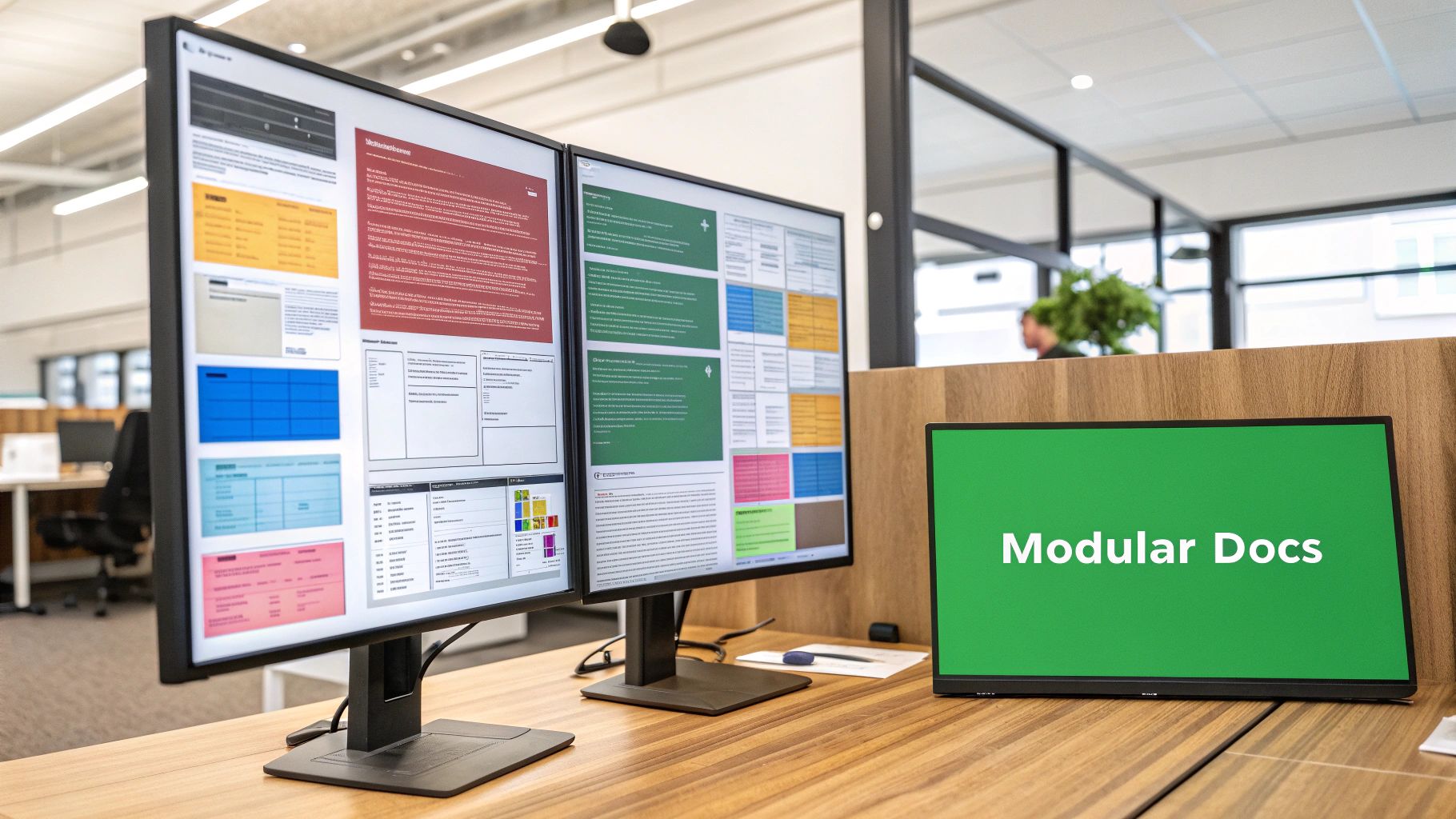Ready to Elevate Your Tech Writing?
In the fast-paced world of tech, where software updates and new technologies are constantly emerging, effective communication is essential. Whether you’re a software developer, a startup founder, or part of a larger engineering team, clearly explaining complex technical information is crucial for success. From concise API documentation that empowers developers to user-friendly guides that onboard new customers, well-crafted technical writing has a significant impact. Its history stretches back to the earliest technical manuals, evolving alongside technology from punch cards to cloud computing. The key to any approach is bridging the gap between technical details and user understanding, encouraging adoption and minimizing frustration.
Historically, technical documentation often focused on being comprehensive, sometimes at the expense of clarity, resulting in dense, jargon-filled manuals. However, the modern approach prioritizes a user-centered design, emphasizing simplicity, accessibility, and a focus on the user’s experience. This shift aligns with broader trends in user experience design and reflects the growing need for seamless and intuitive interactions with technology.
Eight Crucial Strategies for 2025
This article explores eight essential strategies and skills for effective technical writing in 2025. By understanding and implementing these concepts, you can create documentation that not only informs but also empowers your audience, regardless of their technical expertise. Prepare to transform your approach to technical documentation and unlock its full potential.
1. Plain Language Approach
The Plain Language Approach is foundational to effective technical writing. It prioritizes clarity, conciseness, and accessibility, ensuring technical content is easily understood by its intended audience, regardless of technical expertise. This means stripping away jargon, simplifying sentences, and organizing information logically. It’s about making complex topics digestible for everyone—from seasoned software engineers to non-technical end-users.

This approach relies on several key features: simplified vocabulary and sentence structure, reader-focused content organization, the elimination of unnecessary technical jargon, and a sharp focus on clarity and conciseness. Together, these elements create documentation that is both informative and easy to understand.
The benefits are numerous. Plain language improves comprehension across varying audience knowledge levels, leading to fewer support requests due to confusing documentation. This saves time and resources for both writers and readers. Importantly, it makes technical information accessible to non-technical stakeholders, clients, or colleagues in other departments.
However, implementing a plain language approach has challenges. Oversimplification of complex technical concepts is a potential pitfall. Finding the balance between simplicity and technical accuracy requires careful thought. Sometimes, plain language explanations require more space than concise, jargon-heavy terminology.
Pros of Plain Language
- Improved comprehension across different audience knowledge levels
- Reduced support requests
- Time savings for writers and readers
- Increased accessibility for non-technical users
Cons of Plain Language
- Potential oversimplification of complex concepts
- Difficulty balancing simplicity and accuracy
- May require more space to explain concepts The Plain Language Approach has been championed by usability experts like Jakob Nielsen and documentation specialists like Ginny Redish. The movement has institutional support, including the U.S. government’s Plain Language Act of 2010, mandating clear communication. The UK government also emphasizes plain English in its content design guidelines. Microsoft’s Writing Style Guide emphasizes plain language principles, demonstrating its widespread adoption in tech.
Tips for Implementing Plain Language
- Use active voice and speak directly to the reader.
- Check readability with tools like the Hemingway Editor.
- Define technical terms when necessary.
- Use bullet points and lists for complex information.
- Keep sentences under 25 words when possible. Real-world examples include Microsoft’s documentation, known for its clarity, and the Gov.uk website, a model of accessible government information. These examples highlight the effectiveness of plain language in diverse settings. You might also find this helpful: Our guide on enhancing technical writing skills.
The Plain Language Approach is essential for effective communication in technical writing. For software developers, engineers, tech startups, and businesses, clear and accessible documentation is crucial for product adoption, user satisfaction, and overall success. By prioritizing plain language, technical writers bridge the gap between complex technologies and users, fostering understanding and empowering everyone to interact effectively with technology.
2. Structured Authoring
Structured authoring represents a significant change in how we approach technical writing. It moves away from large, single documents and embraces a modular, component-based system. Instead of starting each document from scratch, writers create smaller, independent “chunks” of information, often called topics or modules.
These modules are then combined and reused across many different outputs. This could be anything from online help systems and PDFs to even mobile apps. This approach, illustrated in the image below, allows for single-sourcing. This means there’s one central source of truth for all content. It dramatically improves efficiency, consistency, and scalability in technical documentation.

Key Features and Benefits
What characterizes structured authoring? Here are a few key aspects:
Content organized in reusable modules or topics: This granular approach maximizes reuse and flexibility in how you deliver content.
Separation of content from presentation: Content is written independently of its final format. This allows output to various formats (HTML, PDF, etc.) without rewriting.
Metadata tagging for improved findability: Metadata tags attached to each module make content easier to find and allow for dynamic content assembly.
Use of XML-based standards like DITA or DocBook: These standards provide a structured framework for content creation and management, ensuring compatibility between systems.
Content management systems (CMS) integration: A CMS built for structured authoring streamlines workflows and makes collaboration easier. The benefits are significant:
Facilitates content reuse, reducing duplication efforts: This saves substantial time and money, especially for large documentation projects.
Ensures consistency across documentation: Reusing modules keeps terminology, style, and information consistent across all outputs.
Streamlines translation and localization processes: Translating only the unique content modules, not entire documents, significantly reduces translation costs and turnaround times.
Enables automated publishing to multiple formats: Content can be automatically assembled and published to various platforms and devices, increasing efficiency and reach.
Makes large-scale documentation more manageable: The modular approach simplifies managing and maintaining large, complex documentation sets.
Pros and Cons
While the advantages are numerous, structured authoring has its challenges:
Pros:
Increased content reuse and reduced redundancy
Improved consistency and accuracy
Streamlined translation and localization
Automated publishing to multiple formats
Enhanced scalability and maintainability Cons:
Steep learning curve for writers used to traditional methods
Requires initial investment in tools, training, and process changes
Can make the writing process more complex, especially at first
May feel restrictive to some writers, particularly for highly creative content
Evolution and Popularity
Structured authoring’s rise is closely linked to the development of XML-based standards like DITA, supported by IBM, and DocBook. Industry leaders like IBM, Microsoft, and Cisco have adopted structured authoring to manage their extensive documentation, proving its effectiveness for large-scale projects. Experts like JoAnn Hackos have also been key in promoting content strategy principles that align with structured authoring. Tools like Adobe FrameMaker, RoboHelp, and Oxygen XML Editor have made it easier to adopt by offering strong authoring and publishing environments.
Practical Tips for Implementation
- Start with a content audit: Figure out what existing content can be repurposed into reusable modules.
- Develop a consistent information architecture: This creates a framework for organizing and categorizing your content modules.
- Invest in proper training for technical writers: Give your team the skills they need to use structured authoring tools and methods effectively.
- Consider a phased approach to implementation: Begin with a pilot project to gain experience and refine your processes before expanding.
- Use content management systems designed for structured authoring: This will streamline workflows and help you get the most out of this approach. Structured authoring is essential for producing scalable, maintainable, and consistent technical documentation in today’s complex technological environment. For software developers, engineers, startups, and businesses of all sizes, adopting structured authoring is a smart investment that yields returns in efficiency, quality, and reach.
3. Minimalism in Technical Documentation

Minimalism in technical documentation is a design philosophy focused on giving users exactly what they need, nothing more. It prioritizes clarity and efficiency. This is achieved through task-oriented writing, concise instructions, and removing any fluff. Users typically approach documentation with a specific task in mind. They don’t want to wade through unnecessary details.
This makes minimalism a key skill for technical writers. The goal is to create effective and user-friendly documentation.
Minimalist documentation takes a user-centered approach. It prioritizes user goals over exhaustively detailing system features.
Core Features of Minimalist Documentation
- Task-oriented approach: Content is structured around specific user tasks. This helps users quickly find what they need.
- Action-centered content organization: Instructions are clear and step-by-step. They often use active voice and imperative mood.
- Focus on user goals: Content directly addresses user objectives, minimizing distractions.
- Elimination of non-essential information: Background information, history, and complex technical details are omitted unless absolutely necessary.
- Progressive disclosure of information: Complex or less-used info is tucked away. Users access it only when needed, often through expandable sections or links.
Benefits of Minimalism
Adopting minimalism offers several advantages:
- Reduces cognitive load: Users can process information more easily when presented with only the essentials.
- Creates scannable documentation: Concise language and clear structure make it easy to scan and find information quickly.
- Decreases time to task completion: Users find what they need and finish tasks faster.
- Reduces translation costs: Less text means lower costs for multilingual documentation.
- Improves user satisfaction: A streamlined experience leads to happier users.
Potential Drawbacks
However, minimalism also has potential downsides:
- Insufficient background: Some users, especially beginners, might need more context.
- Defining “essential”: Figuring out the right level of detail can be tricky and depends on the audience.
- Need for user testing: Testing is essential to ensure nothing important is missing.
- Not suitable for all documentation types: Some documents, like conceptual overviews or API references, might benefit from a more detailed approach.
Influences and Examples
Minimalism in technical communication has been influenced by figures like John Carroll, author of The Nurnberg Funnel, and his focus on task-oriented design, and minimalism researcher Hans van der Meij. The clean style championed by Apple and adopted by style guides like the Microsoft Manual of Style also played a role. Real-world examples include Apple’s and Google’s product documentation, and Stripe’s API documentation.
Implementing Minimalism: Tips and Tricks
Here are some tips for creating minimalist documentation:
- One task per topic: Break down complex procedures into smaller, manageable tasks.
- Active voice and imperative mood: “Click the button” is better than “The button should be clicked.”
- Essential information only: Remove anything that doesn’t directly help the user achieve their goal.
- Use visuals: Diagrams, screenshots, and videos can often replace text.